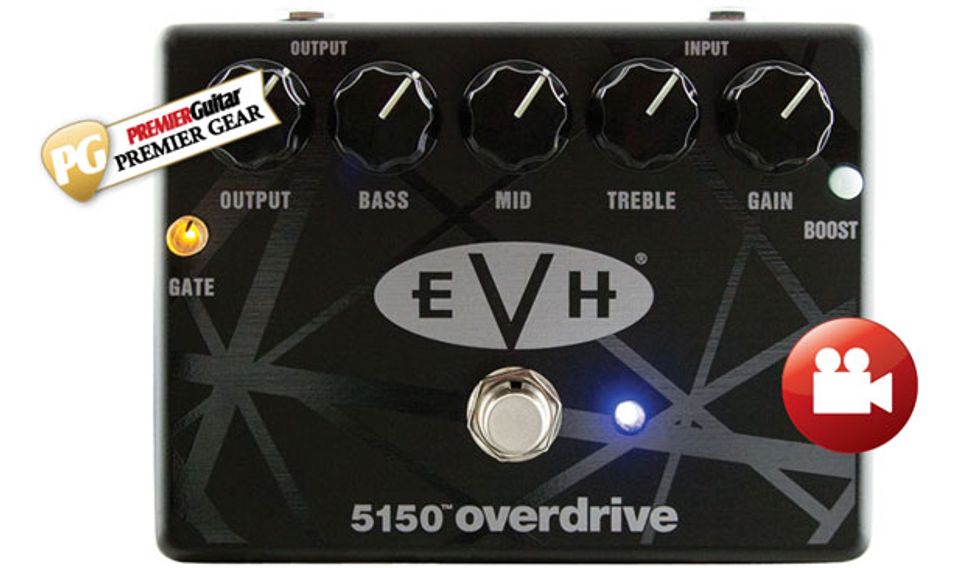MXR’s Eddie Van Halen signature phaser, flanger, and wah pedals made elements of Eddie’s tone available and affordable to the masses. But one of the most critical components in creating his “Brown Sound” is copious amp overdrive. If you don’t have a vintage Marshall Super Lead or an EVH amp (both expensive propositions), the right overdrive pedal is an effective shortcut. And the MOSFET-driven MXR 5150 Overdrive—which was designed by Bob Cedro with input from Mr. Van Halen himself—is a stab at harnessing Eddie’s hot-rodded, high-gain sounds in a pedal.
That’s no mean feat, given that EVH has traditionally been an amp overdrive dude. But the MXR often hits the mark through the use of a flexible set of EQ, drive, and gating controls—as well as a multi-gain-stage design that makes the pedal versatile beyond strictly Eddie-centric applications.
Bigger Box, Bolder Sounds
The 5150 is reminiscent of MXR’s killer big box effects from the ’70s as well as the more recent MXR EVH-117 Flanger. It’s decked out in Eddie’s classic “racing stripe” livery. (Is it now possible to create an entire signal chain in this paint scheme? If there isn’t a cable yet someone should get on it!) The control panel features a common overdrive control set: output, bass, mid, treble, and gain. But there are also two smaller controls: a mini-button for 'boost' (which actually adds a little gain and compression,) and a small knob and a small knob for MXR’s Smart Gate noise gate that turns yellow when activated.
Diver Brown
I tested the 5150 Overdrive with a humbucker-equipped “Super Strat” as well as a traditional, single coil-equipped Stratocaster through the clean channel of a Mesa/Boogie Mark IV. At its lowest gain setting (around 6:30) and with all the tone controls at noon, the MXR turned the Boogie into something more like a cranked tweed Fender—not a stretch, given the Boogie’s design pedigree, but a beautiful, rich distortion sound. Chords took on an aggressive snarl that would excel in a hard rock or classic rock rhythm setting. To get less bite and cleaner tones you need a soft touch, but the fact that approach works is a testament to how dynamic the pedal can be. It’s also surprisingly sensitive: moving the gain up just a hair to around 7 o’clock means a distinct increase in saturation and sustain that’s cool for smoother, more polite lead sounds or heavy rhythm tones.
Move the gain knob to noon and you’re squarely in the distortion camp—verging on the realms of Eddie’s storied in-your-face “Brown Sound.” Here, it’s hard to resist boogie-inflected moves like the lead riff for “Beautiful Girls.” Low, open-string chugs feel punchy and articulate, and the individual notes of chords ring true and clear, which does wonders for big chords with a lot of low-end like Fmaj7#11 or inversions like D/F# and E/G#. The extra clarity found me exploring sonorities and chord clusters that I ordinarily wouldn’t touch with this much gain. For leads, this setting was wicked. Pinch harmonics popped with ease, and tremolo-picked, single-note melodies way up on the fretboard sounded triumphant.
Some of my favorite Van Halen moments occur when Eddie works the shades between clean and dirty sounds in a song, and the MXR is responsive in a way that makes these shades available with a slight shift in guitar volume. And I could move from a massive wall of sound to the familiar Van Halen, quiet, clean-ish rhythm (think of the interlude after the “House of Pain” solo, or the intro of “Drop Dead Legs”) with just a flick of the guitar volume control.
Ratings
Pros:
Perfectly nails the essence of the Eddie Van Halen sound, and then some.
Cons:
Could be pricey for some.
Tones:
Ease of Use:
Build/Design:
Value:

Street:
$199
MXR 5150 Overdrive
jimdunlop.com
Maxing the gain generates massive sounds that could be mistaken for a raging stack of amps. For modern metal rhythms, the sound is tight and especially potent. Soloing also felt amazingly easy with this much gain, and with the noise gate keeping stray harmonics and noise under control, a lot of inconvenient mistakes became a lot less pronounced! That said, the superb definition and focus of the pedal rewarded precision. Alternate picked, scalar sequences popped with percussiveness like a typewriter in the hands of a transcription wiz. Most other pedals or ultra high-gain amps would turn into a nebulous blob of noise at this point. The 5150 Overdrive stayed exceptionally open and detailed.
The added compression and gain from the 'boost' function adds a slight but perceptible bump (+6 dB.) Predictably, it doesn’t feel quite like a boost in the most familiar sense. Instead it feels more like an additional texture—adding dimension and a little extra harmonic breadth to an already very happening sound.
Noise Police
When you use a lot of gain, you get a lot of noise. Usually, I’ll tame the noise (if it can be tamed) via muting techniques. With the 5150 Overdrive’s smart gate engaged, the pedal is so quiet that I sometimes forgot it was on. To really test the gate, I plugged in my Stratocaster, which can be unbearably noisy. It did wonders mitigating the Strat’s pesky hum, even with the gate set at near-minimum levels. The feature is a major plus. After using this pedal for a few weeks, it was almost hard to go back to a gate-less setup.
The Verdict
Eddie Van Halen’s playing has always been about inventiveness, and the 5150 takes a pretty inventive approach to the overdrive pedal template. While the 5150 name might imply that it’s strictly a “Brown-Sound-in-a-box” device, it’s far from one-dimensional. This little box can deliver virtually any overdrive/distortion sound with a vengeance.
The 5150 Overdrive’s near $200 price tag might be a little more than consumers are used to from MXR. But the fact that this pedal can decimate many boutique pedals that do much less makes it a killer buy.
Watch the Review Demo:








![Rig Rundown: Russian Circles’ Mike Sullivan [2025]](https://www.premierguitar.com/media-library/youtube.jpg?id=62303631&width=1245&height=700&quality=70&coordinates=0%2C0%2C0%2C0)


























